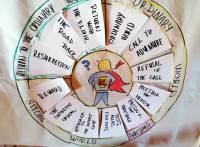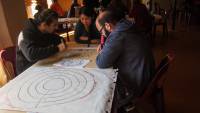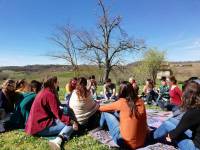User Tools
Sidebar
Table of Contents

The "Hero's Journey" as a tool to accompany young people in their learning journeys
Objectives
- Familiarizing the participants with the Hero’s Journey's (based on Joseph Campbell’s works)
- Experiencing the tool and highlighting its relevance for supporting young people in their learning journey
- Discussing about the inputs of story-telling in youth and social work.
Scenario
Duration: 3 hours
> STEP 1 - 45 min - Getting familiar with the Hero's Journey
 The “Hero’s Journey” is a common template of stories with specific acts and archetypes describing the evolution of a person (cf Joseph Campbell: The Hero with a Thousand Faces).
Beyond litterature, this template can be used by youth workers to support young people in their learning journey. The “Hero's Journey” becomes then a metaphor of the various steps the person is going through.
The “Hero’s Journey” is a common template of stories with specific acts and archetypes describing the evolution of a person (cf Joseph Campbell: The Hero with a Thousand Faces).
Beyond litterature, this template can be used by youth workers to support young people in their learning journey. The “Hero's Journey” becomes then a metaphor of the various steps the person is going through.
For introducing the Hero's Journey, you can first warm up the participants with a playful energizer which will bring them to the most significant steps of the journey.
As soon as the energizer ends, gather the participants in the working room for a short video-screening of a TED video about the Hero's Journey Rephrase it with the participants and give a practical example so that they can better understand how the tool can be used in the frame of a learning mobility project. Distribute the template to all participants as a reminder of the frame:
| The Hero's Journey - Acts | The (young) participants' journey (within the frame of a learning mobility project) | |
|---|---|---|
| ACT 1. Ordinary World | 1. Ordinary world – Hero’s everyday life, description of hero’s character: their nature, capabilities, way of living. | The Identity of the participant, his/her context, way of living, already existing competencies. |
| 2. Call to Adventure – The call ultimately disrupts the comfort of the Hero's Ordinary World and presents a challenge or quest that must be undertaken. It can be a threat, or any kind of discomfort. | Motivation of the participant: discomfort caused by something in theit ordinary world, affecting them or people important for them; something they wants to change in their life. | |
| 3. Refusal of the call – The Hero has second thoughts or even deep personal doubts as to whether or not he/she is up to the challenge. When this happens, the Hero will refuse the call and as a result may suffer somehow. | A memory of passiveness when the participant first recognize that there is a challenge to face; fears, doubts, reasons for not acting. The effect of this passiveness on the participant’s life. | |
| 4. Meeting the mentor – The Hero meets a mentor who provides guidance: they could be given an object of great importance, insight into the dilemma they face, wise advice, practical training or even self-confidence. | People and situations that pushed somehow the participant to take a step and act on their challenge, make a first move towards the change they wants to see. (They can be people and situations from already before the selection as participant, and also the partner organisations who are supporting and preparing the participant. | |
| Threshold | 5. Passing the Threshold – The Hero is now ready to act upon their call to adventure and truly begins their quest, whether it will be physical, spiritual or emotional. They may go willingly or may be pushed, but either way they finally cross the threshold between the world they are familiar with and that which they are not. | Setting objectives and committing to the project. The Moment of starting the mobility (youth exchange, training course, voluntary service…)! Entering in an unfamiliar situation. |
| ACT 2. Special World | 6. Tests, Allies, Enemies – The Hero begins their journey. They need to find out who can be trusted and who can't. They may earn allies and meet enemies who will, each in their own way, help prepare them for the greater ordeals yet to come. This is the stage where their skills and/or powers are tested and every obstacle that they face helps us gain a deeper insight into their character. | Test: The obstacles that the participant face during the mobility project. Obstacles that can be overcome, if he/she tries and look for support. After each test the participant evaluate what he/she has gained (e.g. during the daily reflection groups, reflecting on the learning outcomes of the day). Allies: Support the participant finds during the mobility, which can be various things: peer support, support from the youth leaders and facilitators, the supporting environment, already existing qualities and knowledge he/she brought with him/herself.Enemies: Things, people, circumstances that obstacle he/she to reach his/her objective(s), and in overall to feel well. |
| 7. Approach To The Inmost Cave – The Hero enters into the Cave to face their biggest challenge. They may once again face some of the doubts and fears that first surfaced upon their call to adventure. They may need some time to reflect upon their journey and the treacherous road ahead in order to find the courage to continue. | Mid-term evaluation moments will be used to represent the Approach to the inmost cave. The participant will look back on the path he/she has already done and will look on the upcoming days, analyzing the changes he/she has to make in order to reach the set objectives. |
|
| 8. The Supreme Ordeal – it may be a dangerous physical test or a deep inner crisis that the Hero must face. They must draw upon all of their skills and their experiences gathered upon the journey in order to overcome their most difficult challenge. This is the high-point of the Hero's story and where everything they hold dear is put on the line. Either they win or fail, their life will never be the same again. | Final evaluation moment: Looking back to the most difficult moment during the mobility project, the moment that the participant identifies as “life changing”. To identify this moment, he/she will reconstruct the whole journey and reflect on its different elements, moments, difficulties, the gained competencies etc. | |
| 9. Reward (Seizing the Sword) – After defeating the enemy, surviving death and finally overcoming their greatest personal challenge, the Hero is ultimately transformed into a new state, emerging from battle as a stronger person and often with a prize. The Reward may come in many forms: an object of great importance or power, a secret, greater knowledge or insight. | Final evaluation moment: Learning outcomes of the participant (skills, attitudes, knowledge, other). Assessing the changes in the character: before the mobility and at the end of it. |
|
| ACT 3. Return to the Ordinary World | 10. The Road Back – The Hero's journey is not yet over and they may still need one last push back into the Ordinary World. The moment before the Hero finally commits to the last stage of their journey may be a moment in which they must choose between their own personal objective and that of a Higher Cause. | Returning to the ordinary life of the participant after the mobility can be shocking and disturbing – he/she has changed, but things at home are still the same. This is the moment where youth workers have to remind he/she (through follow-up and reintegration activities) that he/she left because he/she wanted to trigger some changes in his/her life: it is a reflection moment on how he/she can use the gained knowledge and competencies to serve also his/her community and to trigger changes. |
| 11. Resurrection – This is the climax in which the Hero must have their final and most dangerous encounter with death. The final battle also represents something far greater than the Hero's own existence with its outcome having far-reaching consequences to his Ordinary World and the lives of those they left behind. Ultimately the Hero will succeed, destroy their enemy and emerge from battle cleansed and reborn. | Evaluation moment after the project (during the local assessment sessions): To what level the participant has reached his/her overall objective? (Not the learning objectives, which are the “rewards”, but the change he/she wanted to see.) On “his/her way to return”, so since he/she came back home, has he/she used the things he/she gained during the mobility? | |
| 12. Return with the Elixir – This is the final stage of the Hero's journey in which they return home to their Ordinary World a changed man. They will have grown as a person, learned many things, faced many terrible dangers and even death but now look forward to the start of a new life. Their return may bring fresh hope to those they left behind, a direct solution to their problems or perhaps a new perspective for everyone to consider. | Follow-up activities: the participant puts in action his/her ideas and initiatives, bringing positive societal changes. (Can be implemented and monitored in long term.) | |
> STEP 2 - 1 hour 15 minutes - Analysing archetypes, linking one' own experience to the model
Divide the participants in 5 working groups. Distribute to each:
- a set of cards of archetypes: 3-4 persons, 3-4 objects, 3-4 events and 3-4 places
- 1 Hero's Journey template on a A3 paper.
 Ask them first to match the cards they received with the Hero's Journey archetypes and to analyze their characteristics.
Ask them first to match the cards they received with the Hero's Journey archetypes and to analyze their characteristics.
One after the other, invite them then to position as many of the cards they can on the template, regarding their own experiences as a reference.
Back to plenary session, invite each working group to share their most significant findings. Draw their attention to the similarities and differences that emerge regarding their results.
> STEP 3 - 45 minutes - Show-casing and analyzing a practical example
To conclude the session, give a practical example of how the Hero's Journey can be translated into an educational tool.
Invite the participants to perfom a critical analysis of the tool, highlighting its strenghts and limits.
> STEP 4 - 15 minutes - Feedbacks and conclusion
Material required
- Laptop and video projector
- Internet connection or the “Hero's Journey” video downloaded
- The Hero’s Journey template illustrated on a flipchart
- The Hero's Journey template illustrated on 5 x A3 papers (=1 A3/group)
- “Once upon a time” board game cards (15 x 4 categories)
- Paper and pens
- Examples of well known stories (books, movies, myths etc.)




